Enhancement of Catalytic Activity and Durability of Pt Nanoparticle through Strong Chemical Interaction with Electrically Conductive Support of Magnéli Phase Titanium Oxide
Abstract
:1. Introduction
2. Experimental
2.1. Preparation of MPTO
2.2. Preparation of Pt/MPTO and Pt/C
3. Characterizations
3.1. Physicochemical Characterizations
3.2. Electrochemical Characterizations
3.3. Model Systems and Computational Detail
4. Results and Discussion
4.1. Interaction of Pt NP and Supports
4.2. Ab-Initio Investigation of Durability of Pt NP on Carbon and MPTO
4.3. Catalytic Properties of MPTO Supported Pt NPs
4.4. Characterization of MPTO and Pt/MPTO
4.5. Electrochemical Studies
5. Conclusions
Supplementary Materials
Author Contributions
Funding
Institutional Review Board Statement
Informed Consent Statement
Data Availability Statement
Acknowledgments
Conflicts of Interest
References
- Rabis, A.; Rodriguez, P.; Schmidt, T.J. Electrocatalysis for polymer electrolyte fuel cells: Recent achievements and future challenges. ACS Catal. 2012, 2, 864–890. [Google Scholar] [CrossRef]
- Carter, D.; Ryan, M.; Wing, J. The Fuel Cell Industry Review 2013. Platin. Met. Rev. 2013, 57, 310. [Google Scholar] [CrossRef]
- Yang, Y.; Song, Y.; Sun, H.; Xiang, D.; Jiang, Q.; Lu, Z.; He, H.; Huang, H. Rh-decorated three-dimensional graphene aerogel networks as highly-efficient electrocatalysts for direct methanol fuel cells. Front. Energy Res. 2020, 8, 8. [Google Scholar] [CrossRef]
- Zheng, H.B.; An, L.; Zheng, Y.; Qu, C.; Fang, Y.; Liu, Q.; Dang, D. Tuning the catalytic activity of Ir@Pt nanoparticles through controlling Ir core size on cathode performance for PEM fuel cell application. Front. Chem. 2018, 6, 299. [Google Scholar] [CrossRef] [PubMed]
- Noel, J.M.; Yu, Y.; Mirkin, M.V. Dissolution of Pt at moderately negative potentials during oxygen reduction in water and organic media. Langmuir 2013, 29, 1346–1350. [Google Scholar] [CrossRef]
- Brouzgou, A.; Seretis, A.; Song, S.; Shen, P.K.; Tsiakaras, P. CO tolerance and durability study of PtMe(Me = Ir or Pd) electrocatalysts for H2-PEMFC application. Int. J. Hydrogen Energy 2020. [Google Scholar] [CrossRef]
- Tian, Z.Q.; Lim, S.H.; Poh, C.K.; Tang, Z.; Xia, Z.; Luo, Z.; Shen, P.K.; Chua, D.; Feng, Y.P.; Shen, Z.; et al. A highly order-structured membrane electrode assembly with vertically aligned carbon nanotubes for ultra-low Pt loading PEM fuel cells. Adv. Energy Mater. 2011, 1, 1205–1214. [Google Scholar] [CrossRef]
- Murata, S.; Imanishi, M.; Hasegawa, S.; Namba, R. Vertically aligned carbon nanotube electrodes for high current density operating proton exchange membrane fuel cells. J. Power Sources 2014, 253, 104–113. [Google Scholar] [CrossRef]
- Hwang, S.M.; Park, J.H.; Lim, S.; Jung, D.H.; Guim, H.; Yoon, Y.G.; Yim, S.D.; Kim, T.Y. Designing an ultrathin silica layer for highly durable carbon nanofibers as the carbon support in polymer electrolyte fuel cells. Nanoscale 2014, 6, 12111–12119. [Google Scholar] [CrossRef]
- Ghosh, A.; Basu, S.; Verma, A. Graphene and functionalized graphene supported platinum catalyst for PEMFC. Fuel Cells 2013, 13, 355–363. [Google Scholar] [CrossRef]
- Antolini, E. Graphene as a new carbon support for low-temperature fuel cell catalysts. Appl. Catal. B Environ. 2012, 123–124, 52–68. [Google Scholar] [CrossRef]
- Zhong, X.; Ye, S.; Tang, J.; Zhu, Y.; Wu, D.; Gu, M.; Pan, H.; Xu, B. Engineering Pt and Fe dual-metal single atoms anchored on nitrogen-doped carbon with high activity and durability towards oxygen reduction reaction for zinc-air battery. Appl. Catal. B Environ. 2021, 286, 119891. [Google Scholar] [CrossRef]
- Krishnan, P.; Advani, S.; Prasad, A.K. Magneli phase Ti n O2n—1 as corrosion-resistant PEM fuel cell catalyst support. J. Solid State Chem. 2012, 16, 2515–2521. [Google Scholar] [CrossRef]
- Yao, C.; Li, F.; Li, X.; Xia, D. Fiber-like nanostructured Ti4O7 used as durable fuel cell catalyst support in oxygen reduction catalysis. J. Mater. Chem. 2012, 22, 16560. [Google Scholar] [CrossRef]
- Kakinuma, K.; Chino, Y.; Senoo, Y.; Uchida, M.; Kamino, T.; Uchida, H.; Deki, S.; Watanabe, M. Characterization of Pt catalysts on Nb-doped and Sb-doped SnO2–δ support materials with aggregated structure by rotating disk electrode and fuel cell measurements. Electrochim. Acta. 2013, 110, 316–324. [Google Scholar] [CrossRef]
- Shao, Y.; Liu, J.; Wang, Y.; Lin, Y. Novel catalyst support materials for PEMfuelcells: Current status and future prospects. J. Mater. Chem. 2009, 19, 46–59. [Google Scholar] [CrossRef]
- Yang, D.H.; Sui, X.L.; Zhao, L.; Huang, G.S.; Gu, D.M.; Wang, Z.B. Pt supported on carbon-coating antimony Tin oxide as anode catalyst for direct methanol fuel cell. Fuel Cells 2018, 18, 763–770. [Google Scholar] [CrossRef]
- Naik, K.M.; Higuchi, E.; Inoue, H. Two-dimensional oxygen-deficient TiO2 nanosheets-supported Pt nanoparticles as durable catalyst for oxygen reduction reaction in proton exchange membrane fuel cells. J. Power Sources 2020, 455, 227972. [Google Scholar] [CrossRef]
- Alipour Moghadam Esfahani, R.; Ebralidze, I.I.; Specchia, S.; Easton, E.B. A fuel cell catalyst support based on doped titanium suboxides with enhanced conductivity, durability and fuel cell performance. J. Mater. Chem. A 2018, 6, 14805–14815. [Google Scholar] [CrossRef]
- Jeon, Y.; Ji, Y.; Cho, Y.I.; Lee, C.; Park, D.H.; Shul, Y.G. Oxide-carbon nanofibrous composite support for a highly active and stable polymer electrolyte membrane fuel-cell catalyst. ACS Nano 2018, 12, 6819–6829. [Google Scholar] [CrossRef]
- Sullivan, M.T.; Alipour Moghadam Esfahani, R.; Easton, E.B. Conductive metal oxide-based fuel cell catalyst supports prepared by doping TiO2 with Si understanding the role of Si content. EXS Trans. 2020, 97, 659–670. [Google Scholar] [CrossRef]
- Wang, J.; Yin, G.; Shao, Y.; Zhang, S.; Wang, Z.; Gao, Y. Effect of carbon black support corrosion on the durability of Pt/C catalyst. J. Power Sources 2007, 171, 331–339. [Google Scholar] [CrossRef]
- Maass, S.; Finsterwalder, F.; Frank, G.; Hartmann, R.; Merten, C. Carbon support oxidation in PEM fuel cell cathodes. J. Power Sources 2008, 176, 444–451. [Google Scholar] [CrossRef]
- Tang, H.; Qi, Z.; Ramani, M.; Elter, J.F. PEM fuel cell cathode carbon corrosion due to the formation of air/fuel boundary at the anode. J. Power Sources 2006, 158, 1306–1312. [Google Scholar] [CrossRef]
- Hacker, V.; Baumgartner, W.; Wallnöfer, E.; Schaffer, T.; Besenhard, J.O. Characterization of carbon nanofiber-based fuel cell electrodes. EXS Trans. 2006, 3, 295. [Google Scholar] [CrossRef]
- Bartholomew, R.F.; Frankl, D.R. Electrical properties of some titanium oxides. Phys. Rev. B 1969, 187, 828–833. [Google Scholar] [CrossRef]
- Chen, G.; Bare, S.R.; Mallouk, T.E. Development of supported bifunctional electrocatalysts for unitized regenerative fuel cells. J. Electrochem. Soc. 2002, 149, A1092. [Google Scholar] [CrossRef]
- Ioroi, T.; Siroma, Z.; Fujiwara, N.; Yamazaki, S.; Yasuda, K. Sub-stoichiometric titanium oxide-supported platinum electrocatalyst for polymer electrolyte fuel cells. Electrochem. Commun. 2005, 7, 183–188. [Google Scholar] [CrossRef]
- Ioroi, T.; Senoh, H.; Yamazaki, S.; Siroma, Z.; Fujiwara, N.; Yasuda, K. Stability of corrosion-resistant Magnéli-phase Ti4O7-supported PEMFC catalysts at high potentials. J. Electrochem. Soc. 2008, 155, B321. [Google Scholar] [CrossRef]
- Dogan, D.C.; Hwang, S.M.; Jang, E.H.; Yim, S.D.; Sohn, Y.J.; Kim, S.H.; Yang, T.H.; Park, G.G. Highly platinum-loaded Magneli phase titanium oxides as a high voltage tolerant electrocatalyst for polymer electrolyte fuel cells. J. Nanosci. Nanotechnol. 2015, 15, 6988–6994. [Google Scholar] [CrossRef]
- Islam, J.; Kim, S.K.; Kim, K.H.; Lee, E.; Park, G.G. Enhanced durability of Pt/C catalyst by coating carbon black with silica for oxygen reduction reaction. Int. J. Hydrogen Energy 2021, 46, 1133–1143. [Google Scholar] [CrossRef]
- Warschkow, O.; Wang, Y.; Subramanian, A.; Asta, M.; Marks, L.D. Structure and local-equilibrium thermodynamics of the c(2x2) reconstruction of rutile TiO2 (100). Phys. Rev. Lett. 2008, 100, 086102. [Google Scholar] [CrossRef]
- Wang, Y.; Warschkow, O.; Marks, L.D. Surface evolution of rutile TiO2 (100) in an oxidizing environment. Surf. Sci. 2007, 601, 63–67. [Google Scholar] [CrossRef]
- Yoshida, K.; Kawai, T.; Nambara, T.; Tanemura, S.; Saitoh, K.; Tanaka, N. Direct observation of oxygen atoms in rutile titanium dioxide by spherical aberration corrected high-resolution transmission electron microscopy. Nanotechnology 2006, 17, 3944–3950. [Google Scholar] [CrossRef]
- Kresse, G.; Furthmuller, J. Efficient iterative schemes for ab initio total-energy calculations using a plane-wave basis set. Phys. Rev. B 1996, 54, 11169–11186. [Google Scholar] [CrossRef]
- Blochl, P.E. Projector augmented-wave method. Phys. Rev. B Condens. Matter 1994, 50, 17953–17979. [Google Scholar] [CrossRef]
- Kresse, G.; Joubert, D. From ultrasoft pseudopotentials to the projector augmented-wave method. Phys. Rev. B 1999, 59, 1758–1775. [Google Scholar] [CrossRef]
- Perdew, J.P.; Burke, K.; Ernzerhof, M. Generalized gradient approximation made simple. Phys. Rev. Lett. 1996, 77, 3865–3868. [Google Scholar] [CrossRef]
- Blochl, P.E.; Jepsen, O.; Andersen, O.K. Improved tetrahedron method for Brillouin-zone integrations. Phys. Rev. B Condens. Matter 1994, 49, 16223–16233. [Google Scholar] [CrossRef]
- Wang, Y.J.; Wilkinson, D.P.; Zhang, J. Noncarbon support materials for polymer electrolyte membrane fuel cell electrocatalysts. Chem. Rev. 2011, 111, 7625–7651. [Google Scholar] [CrossRef]
- Feldberg, S.W.; Enke, C.G.; Bricker, C.E. Formation and dissolution of platinum oxide film: Mechanism and kinetics. J. Electrochem. Soc. 1963, 110, 826–834. [Google Scholar] [CrossRef]
- Seo, M.H.; Choi, S.M.; Lim, E.J.; Kwon, I.H.; Seo, J.K.; Noh, S.H.; Kim, W.B.; Han, B. Toward new fuel cell support materials: A theoretical and experimental study of nitrogen-doped graphene. ChemSusChem 2014, 7, 2609–2620. [Google Scholar] [CrossRef]
- Higgins, D.; Hoque, M.A.; Seo, M.H.; Wang, R.; Hassan, F.; Choi, J.Y.; Pritzker, M.; Yu, A.; Zhang, J.; Chen, Z. Development and simulation of sulfur-doped graphene supported platinum with exemplary stability and activity towards oxygen reduction. Adv. Funct. Mater. 2014, 24, 4325–4336. [Google Scholar] [CrossRef]
- Seo, M.H.; Park, H.W.; Lee, D.U.; Park, M.G.; Chen, Z. Design of highly active perovskite oxides for oxygen evolution reaction by combining experimental and ab Initio studies. ACS Catal. 2015, 5, 4337–4344. [Google Scholar] [CrossRef]
- Lundqvist, B.I.; Gunnarsson, O.; Hjelmberg, H. Theoretical description of molecure-metal interaction and surface reactions. Surf. Sci. 1979, 89, 196–225. [Google Scholar] [CrossRef]
- Hammer, B.; Norskov, J.K. Why gold is the noblest of all the metals. Lett. Nat. 1995, 376, 238–240. [Google Scholar] [CrossRef]
- Hammer, B.; Norskov, J.K. Theoretical Surface Science and Catalysis—Calculations and Concepts. Adv. Catal. 2000, 45, 71–129. [Google Scholar]
- Calle-Vallejo, F.; Díaz-Morales, O.A.; Kolb, M.J.; Koper, M.T.M. Why Is bulk thermochemistry a good descriptor for the electrocatalytic activity of rransition metal oxides? ACS Catal. 2015, 5, 869–873. [Google Scholar] [CrossRef]
- Calle-Vallejo, F.; Martinez, J.I.; Garcia-Lastra, J.M.; Mogensen, M.; Rossmeisl, J. Trends in stability of perovskite oxides. Angew. Chem. Int. Ed. 2010, 49, 7699–7701. [Google Scholar] [CrossRef]
- Calle-Vallejo, F.; Inoglu, N.G.; Su, H.Y.; Martínez, J.I.; Man, I.C.; Koper, M.T.M.; Kitchin, J.R.; Rossmeisl, J. Number of outer electrons as descriptor for adsorption processes on transition metals and their oxides. Chem. Sci. 2013, 4, 1245. [Google Scholar] [CrossRef]
- Bader, R.F. Atoms in Molecules; Wiley online Library: Hoboken, NJ, USA, 1990. [Google Scholar]
- Seo, J.K.; Khetan, A.; Seo, M.H.; Kim, H.; Han, B. First-principles thermodynamic study of the electrochemical stability of Pt nanoparticles in fuel cell applications. J. Power Sources 2013, 238, 137–143. [Google Scholar] [CrossRef]
- Jinnouchi, R.; Toyoda, E.; Hatanaka, T.; Morimoto, Y. First principles calculations on site-dependent dissolution potentials of supported and unsupported Pt particles. J. Phys. Chem. C 2010, 114, 17557–17568. [Google Scholar] [CrossRef]
- Noh, S.H.; Seo, M.H.; Seo, J.K.; Fischer, P.; Han, B. First principles computational study on the electrochemical stability of Pt-Co nanocatalysts. Nanoscale 2013, 5, 8625–8633. [Google Scholar] [CrossRef] [PubMed]
- Tang, L.; Han, B.; Persson, K.; Friesen, C.; He, T.; Sieradzki, K.; Ceder, G. Electrochemical stability of nanometer-scale Pt particles in acidic environments. J. Am. Chem. Soc. 2009, 132, 596–600. [Google Scholar] [CrossRef]
- Shao, M.; Liu, P.; Zhang, J.; Adzic, R. Origin of enhanced activity in palladium alloy electrocatalysts for oxygen reduction reaction. J. Phys. Chem. B 2007, 111, 6772–6775. [Google Scholar] [CrossRef]
- Hammer, B.; Norskov, J.K. Electronic factors determining the reactivity of metal surfaces. Surf. Sci. 1995, 343, 211–220. [Google Scholar] [CrossRef]
- Demirci, U.B. Theoretical means for searching bimetallic alloys as anode electrocatalysts for direct liquid-feed fuel cells. J. Power Sources 2007, 173, 11–18. [Google Scholar] [CrossRef]
- Shao, M.; Liu, P.; Zhang, J.; Sasaki, K.; Vukmirovic, M.B.; Adzic, R.R. Palladium monolayer and palladium alloy electrocatalysts for oxygen reduction. Langmuir 2006, 22, 10409–10415. [Google Scholar] [CrossRef]
- Greeley, J.; Mavrikakis, M. Alloy catalysts designed from first principles. Nat. Mater. 2004, 3, 810–815. [Google Scholar] [CrossRef]
- Shao, M.; Sasaki, K.; Marinkovic, N.; Zhang, L.; Adzic, R. Synthesis and characterization of platinum monolayer oxygen-reduction electrocatalysts with Co–Pd core–shell nanoparticle supports. Electrochem. Commun. 2007, 9, 2848–2853. [Google Scholar] [CrossRef]
- Greeley, J.; Stephens, I.E.; Bondarenko, A.S.; Johansson, T.P.; Hansen, H.A.; Jaramillo, T.F.; Rossmeisl, J.; Chorkendorff, I.; Norskov, J.K. Alloys of platinum and early transition metals as oxygen reduction electrocatalysts. Nat. Chem. 2009, 1, 552–556. [Google Scholar] [CrossRef]
- Strasser, P.; Koh, S.; Anniyev, T.; Greeley, J.; More, K.; Yu, C.; Liu, Z.; Kaya, S.; Nordlund, D.; Ogasawara, H.; et al. Lattice-strain control of the activity in dealloyed core-shell fuel cell catalysts. Nat. Chem. 2010, 2, 454–460. [Google Scholar] [CrossRef]
- Lee, Y.; Kleis, J.; Rossmeisl, J.; Morgan, D. Ab initio energetics of LaBO3(001) (B=Mn, Fe, Co, and Ni) for solid oxide fuel cell cathodes. Phys. Rev. B 2009, 80, 224101. [Google Scholar] [CrossRef]
- Pople, J.A.; HeadGordon, M.; Fox, D.J.; Raghavachari, K.; Curtiss, L.A. Gaussian-1 theory: A general procedure for prediction of molecular energies. J. Chem. Phys. 1989, 90, 5622–5629. [Google Scholar] [CrossRef]
- Han, B.C.; Miranda, C.R.; Ceder, G. Effect of particle size and surface structure on adsorption of O and OH on platinum nanoparticles: A first-principles study. Phys. Rev. B 2008, 77, 075410. [Google Scholar] [CrossRef]
- Sattiler, M.L.; Ross, P.N. The surface structure of Pt crystallites supported on carbon black. Ultramicroscopy 1986, 20, 21–28. [Google Scholar] [CrossRef]
- Kinoshita, K. Particle size effects for oxygen reduction on highly dispersed platinum in acid electrolytes. J. Electrochem. Soc. 1990, 137, 845–848. [Google Scholar] [CrossRef]
- Mukerjee, S.; McBreen, J. Effect of particle size on the electrocatalysis by carbon-supported Pt electrocatalysts: An in situ XAS investigation. J. Electroanal. Chem. 1998, 448, 163–171. [Google Scholar] [CrossRef]
- Ekuma, E.E.; Bagayoko, D. Ab-initio electronic and structural properties of rutile titanium dioxide. Jpn. J. Appl. Phys. 2011, 50, 101103. [Google Scholar] [CrossRef]
- Labat, F.; Baranek, P.; Domain, C.; Minot, C.; Adamo, C. Density functional theory analysis of the structural and electronic properties of TiO2 rutile and anatase polytypes: Performances of different exchange-correlation functionals. J. Chem. Phys. 2007, 126, 154703. [Google Scholar] [CrossRef]
- Zhang, J.; Su, N.; Hu, X.; Zhu, F.; Yu, Y.; Yang, H. Facile synthesis of Pt nanoparticles supported on anatase TiO2 nanotubes with good photo-electrocatalysis performance for methanol. RSC Adv. 2017, 7, 56194–56203. [Google Scholar] [CrossRef]
- Huang, K.; Sasaki, K.; Adzic, R.R.; Xing, Y. Increasing Pt oxygen reduction reaction activity and durability with a carbon-doped TiO2 nanocoating catalyst support. J. Mater. Chem. 2012, 22, 16824. [Google Scholar] [CrossRef]
- Mayrhofer, K.J.J.; Blizanac, B.B.; Arenz, M.; Stamenkovic, V.R.; Ross, P.N.; Markovic, N.M. The impact of geometric and surface electronic properties of Pt-catalysts on the particle size effect in electrocatalysis. J. Phys. Chem. B 2005, 109, 14433–14440. [Google Scholar] [CrossRef]
- Jang, J.H.; Kim, J.; Lee, Y.H.; Kim, I.Y.; Park, M.H.; Yang, C.W.; Hwang, S.J.; Kwon, Y.U. One-pot synthesis of core–shell-like Pt3Co nanoparticle electrocatalyst with Pt-enriched surface for oxygen reduction reaction in fuel cells. Energy Environ. Sci. 2011, 4, 4947. [Google Scholar] [CrossRef]
- Shinagawa, T.; Garcia-Esparza, A.T.; Takanabe, K. Insight on Tafel slopes from a microkinetic analysis of aqueous electrocatalysis for energy conversion. Sci. Rep. 2015, 5, 13801. [Google Scholar] [CrossRef]
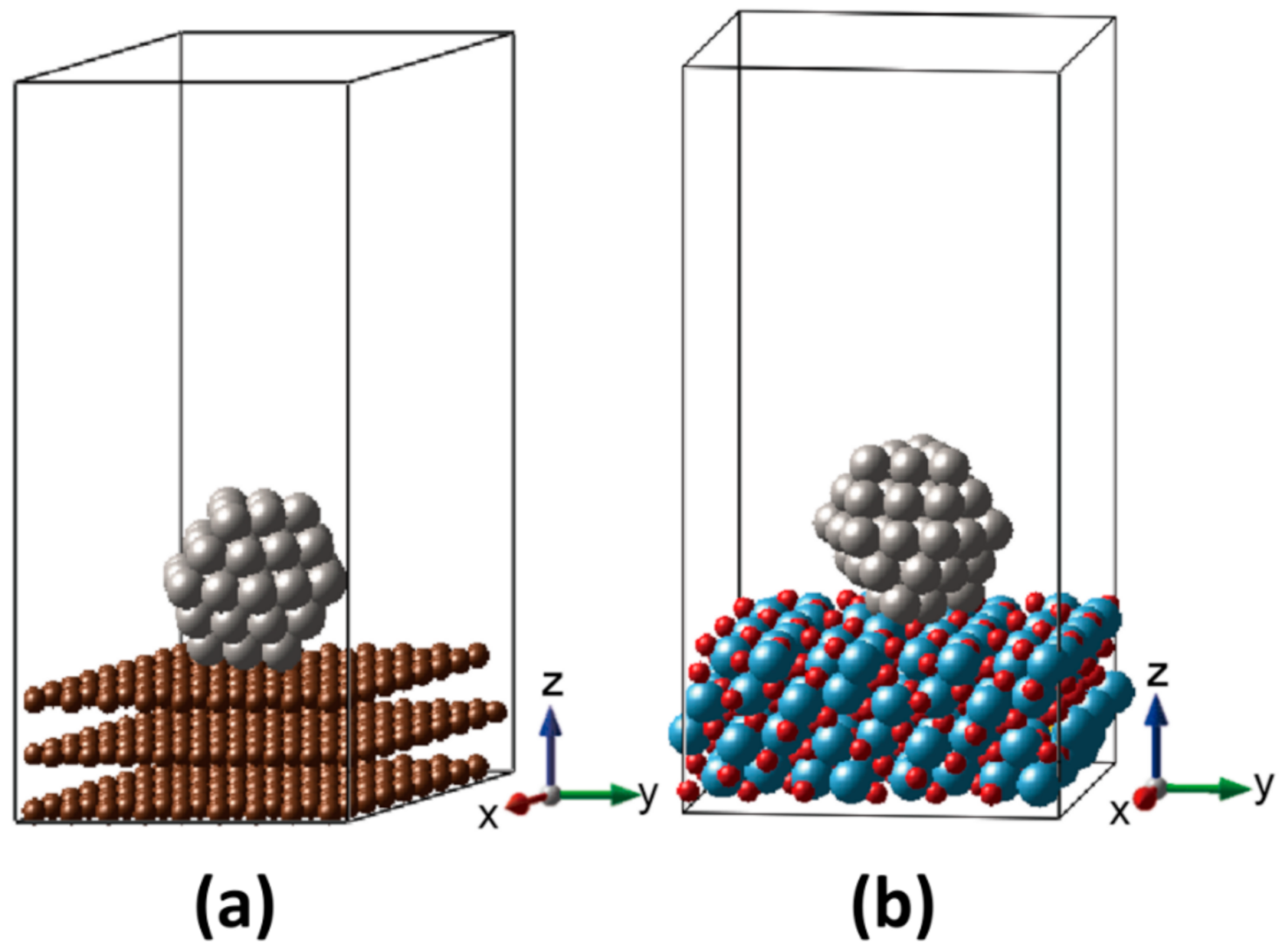
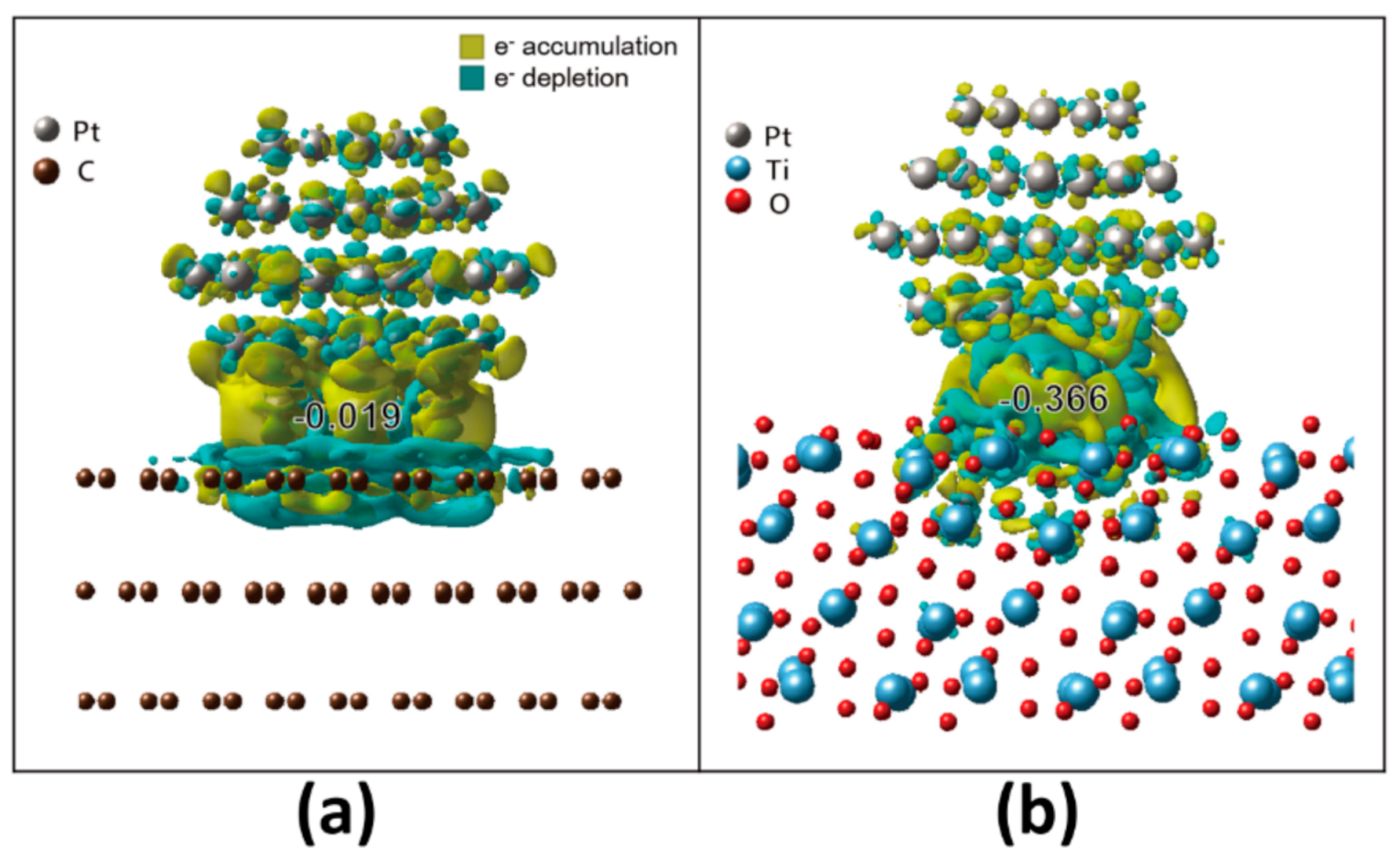
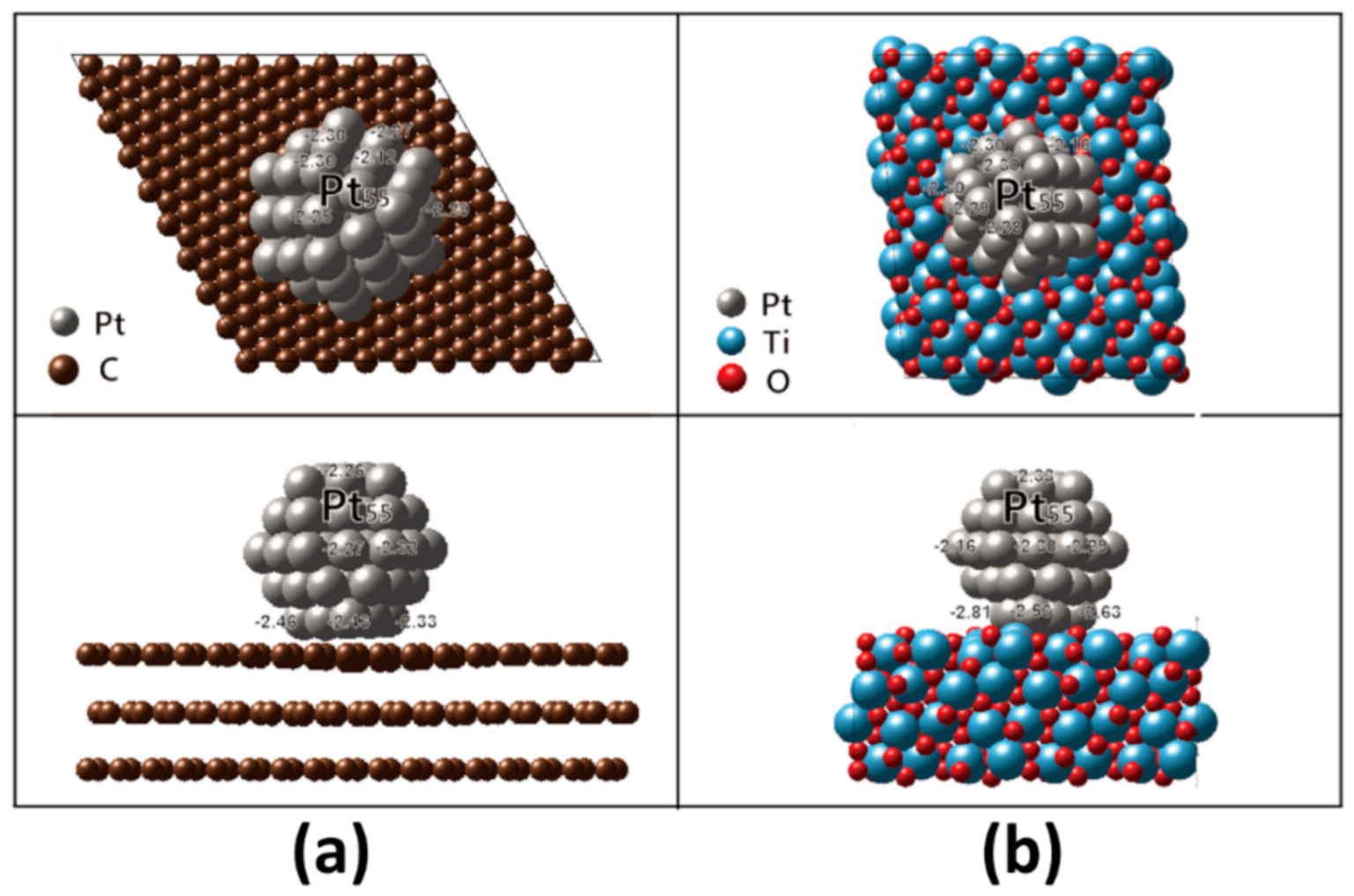

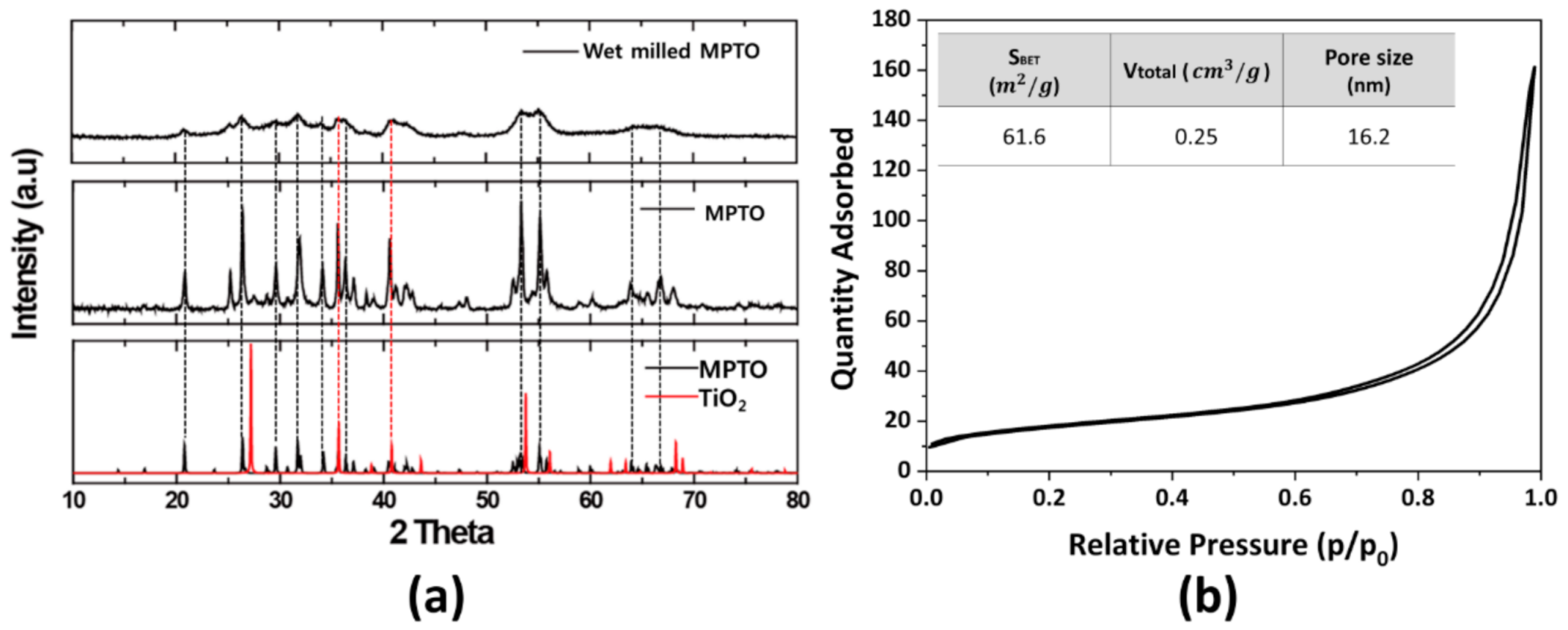
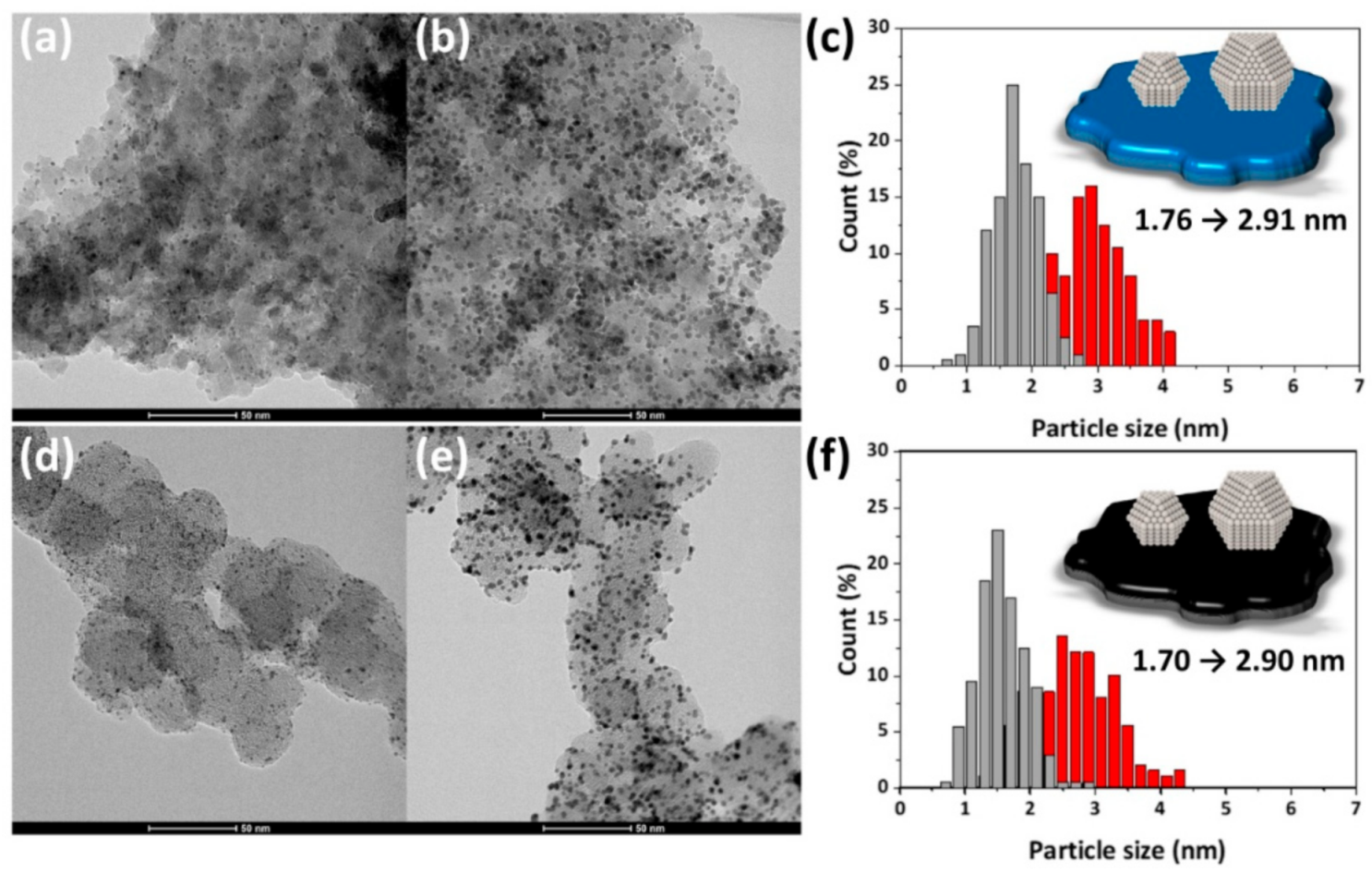


| Atomic Oxygen (eV/O) | ||||||||
|---|---|---|---|---|---|---|---|---|
| Pt (111) 1 | Pt55 NP | Pt55/Graphite | Pt55/MPTO | |||||
| Pt-FCC | Pt-FCC | top-FCC | side-FCC | bottom-FCC | top-FCC | side-FCC | bottom-FCC | |
| Eads, eV | −3.92 | −4.39 | −3.79 | −3.59 | −3.75 | −3.57 | −3.62 | −3.74 |
| ΔEO−ΔEOPt(111), eV | 0 | −0.47 | 0.12 | 0.32 | 0.16 | 0.34 | 0.30 | 0.17 |
| Ecoh, eV | 4.85 | 4.86 | 5.06 | |||||
| Udiss-Pt shell vs. SHE, eV | - | 0.62 | 0.63 | 0.76 | ||||
| Samples | Pt Loading (ICP-MS, wt%) | Particle Size (TEM, nm) | Particle Size (XRD, nm) |
|---|---|---|---|
| Pt/MPTO | 11.4 | 1.76 | - |
| Pt/MPTO | 8.6 | 2.91 | - |
| Pt/C | 19.2 | 1.70 | - |
| Pt/C | 20.1 | 2.90 | 3.00 |
Publisher’s Note: MDPI stays neutral with regard to jurisdictional claims in published maps and institutional affiliations. |
© 2021 by the authors. Licensee MDPI, Basel, Switzerland. This article is an open access article distributed under the terms and conditions of the Creative Commons Attribution (CC BY) license (http://creativecommons.org/licenses/by/4.0/).
Share and Cite
Dogan, D.C.; Choi, J.; Seo, M.H.; Lee, E.; Jung, N.; Yim, S.-D.; Yang, T.-H.; Park, G.-G. Enhancement of Catalytic Activity and Durability of Pt Nanoparticle through Strong Chemical Interaction with Electrically Conductive Support of Magnéli Phase Titanium Oxide. Nanomaterials 2021, 11, 829. https://doi.org/10.3390/nano11040829
Dogan DC, Choi J, Seo MH, Lee E, Jung N, Yim S-D, Yang T-H, Park G-G. Enhancement of Catalytic Activity and Durability of Pt Nanoparticle through Strong Chemical Interaction with Electrically Conductive Support of Magnéli Phase Titanium Oxide. Nanomaterials. 2021; 11(4):829. https://doi.org/10.3390/nano11040829
Chicago/Turabian StyleDogan, Didem C., Jiye Choi, Min Ho Seo, Eunjik Lee, Namgee Jung, Sung-Dae Yim, Tae-Hyun Yang, and Gu-Gon Park. 2021. "Enhancement of Catalytic Activity and Durability of Pt Nanoparticle through Strong Chemical Interaction with Electrically Conductive Support of Magnéli Phase Titanium Oxide" Nanomaterials 11, no. 4: 829. https://doi.org/10.3390/nano11040829
APA StyleDogan, D. C., Choi, J., Seo, M. H., Lee, E., Jung, N., Yim, S. -D., Yang, T. -H., & Park, G. -G. (2021). Enhancement of Catalytic Activity and Durability of Pt Nanoparticle through Strong Chemical Interaction with Electrically Conductive Support of Magnéli Phase Titanium Oxide. Nanomaterials, 11(4), 829. https://doi.org/10.3390/nano11040829






